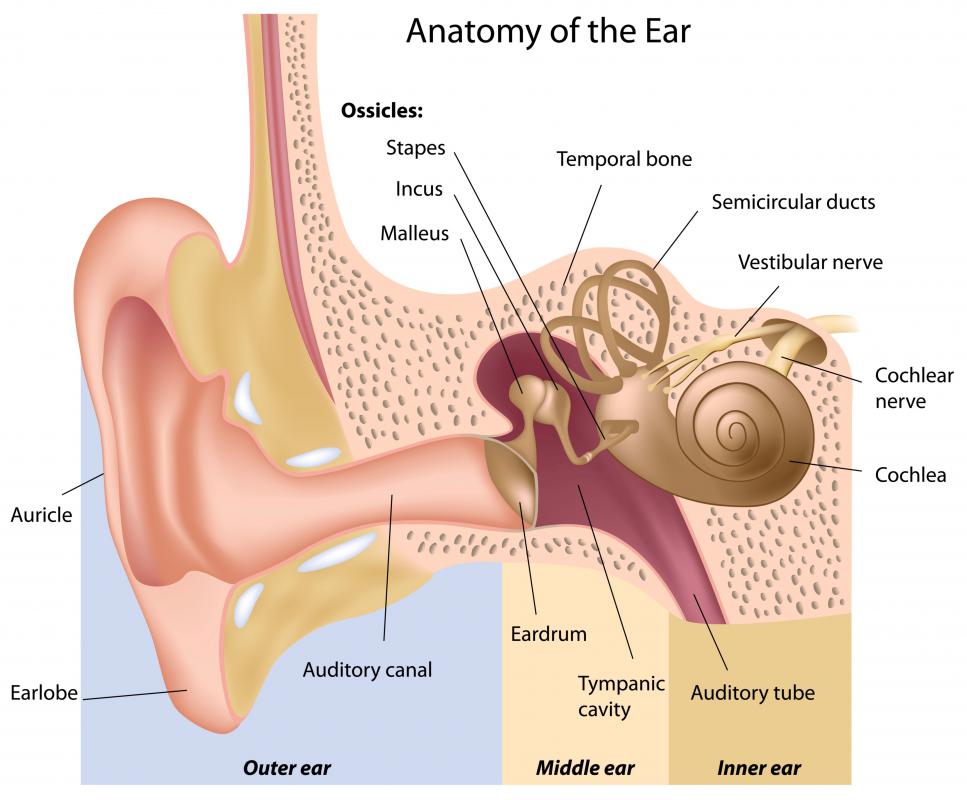At TheHealthBoard, we're committed to delivering accurate, trustworthy information. Our expert-authored content is rigorously fact-checked and sourced from credible authorities. Discover how we uphold the highest standards in providing you with reliable knowledge.
What is the Auditory Canal?
The auditory canal is a tube that connects the pinna, or fleshy outer visible part of the ear, and the tympanic membrane, or eardrum. Together, the pinna and the auditory canal make up the external ear and measure about 1 inch (26 mm) long. The ear canal has two primary functions: helping the auditory process by funneling sound toward the eardrum and protecting the eardrum from injury.
The inner two-thirds of the auditory canal are bony and free of hair and glands. In the cartilaginous outer third of the outer canal, tiny hairs grow perpendicular to the canal wall and help clean the canal. Sebaceous glands produce sebum, an oily substance made up of fats. Cerumenous glands produce cerumen, or earwax, which helps to lubricate the canal and keeps it waterproof. Too much earwax can be a problem when it impacts and causes temporary hearing loss, requiring removal by a doctor.

The ear canal is responsible for amplifying sound and directing it toward the eardrum. From the pinna to the tympanic membrane, sound is increased by 5 to 15 decibels (dB) in the 2,000 to 4,000 Hertz (Hz) range due to the resonance of the auditory canal. The human ear is most sensitive to sound within this range and most vulnerable to damage from noises that are too loud.

Since the auditory canal is so close to the outside of the body, it is susceptible to many disorders, infections, and injuries. Although the depth and curvature of the ear canal provides some protection from injury, they still may occur or objects may become stuck in the ear. Also, the ear is a warm, moist organ and can be an ideal environment for fungal infections to grow. Bacterial infections like otitis externa, also known as swimmer’s ear, can infect the external ear, and may damage the eardrum if not treated.

Cleaning the ear canal is almost never necessary and may be dangerous. The auditory canal is a self-cleansing organ, so external cleansing may interfere with this process. Objects, like cotton swabs, inserted into the ear can damage or even puncture the eardrum.
The auditory canal, like the nail bed, is host to a process called epithelial migration. Skin cells move from the tympanic membrane toward the pinna, helping clean the ear and move foreign objects, earwax, and shed hairs toward the pinna. Some researchers believe that the process is aided by chewing motions, which stretch and shift the ear canal and may help the cells migrate.
AS FEATURED ON:
AS FEATURED ON:















Discussion Comments
I'm always a little concerned about my hearing because I went to quite a few loud concerts that left my ears ringing for days, and I used to use my ear bud headphones to listen to my ipod until I found out that excessive use of that can cause problems as well.
But I just learned about a hearing aid that fits with your auditory canal anatomy (so whether your ear canal is narrow or a bit wider) and you can actually leave your aid in for months at a time.
I thought I would look up the auditory canal and see how that would fit in the canal but with a one inch space to work with I think that was a brilliant move in hearing aid production, thank you auditory canal for hiding my future hearing loss!
@runner101 - I know what you mean - I was quite the cotton swab user in my ears before I took an audiology class in college and learned about the ear's auditory canal.
Turns out that you need some earwax in there (though it has been so long since I took the class I cannot remember why) and you naturally lose earwax in your sleep. More reason to wash those pillowcases frequently!
Another reason not to swab your ear is that your eardrum is at the end of that canal and there have been reports of people putting the cotton swab through their ear drum. That I remember quite well because we were able to see pictures of the eardrum with the cotton swab scars!
So that is the good news if you are addicted to cotton swab use to clean your ear canal, if you do get a little crazy and attack your ear drum, it heals itself, but I would suggest sticking to using those cotton swabs to clean your outer ear and taking off make-up. Or my new favorite use - cleaning around my computer's keyboard keys - works like a charm!
If cleaning the ear canal is not necessary and probably should not be done, then what are cotton swabs for and is it actually bad to swab them. I feel sometimes like I can hear better when I swab them and I get some pretty intense ear wax.
Post your comments